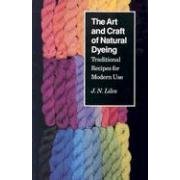How can I use indigo from my garden for dyeing?
Name: MaryEllen
—ADVERTISEMENTS—

A Handbook of Indigo Dyeing
by Vivien Prideaux


A Dyer's Garden
by Rita Buchanan
Includes recipe for using fresh indigo leaves for dyeing

The Art and Craft
of Natural Dyeing:
Traditional Recipes for Modern Use
by J.N. Liles
Hi Paula, I was inspired by the latest issue of Piecework magazine to try indigo dyeing, since I have a fairly “native” garden which includes an indigo plant. With no directions at all, I proceeded to strip off a gallon of leaves and steep them in hot water. Then I read somewhere on the internet that I had to increase the alkalinity with soda ash, so I added one packet of Tulip soda ash. A week later I still had no fermentation at all, so I’ve fished out most of the leaves and am trying that. I know this takes time, but I wanted to see if I’ve ruined the pot with the soda ash while I still have an abundance of leaves on the bush so I can start over if necessary.
I’d really rather not go the urine route, but I can try running water through charcoal ash for lye if necessary. Can you give me the basic steps for truly natural, not too toxic indigo production? Everyone seems to have a different opinion. Thanks for whatever help you can offer.
I’d really rather not go the urine route, but I can try running water through charcoal ash for lye if necessary. Can you give me the basic steps for truly natural, not too toxic indigo production? Everyone seems to have a different opinion. Thanks for whatever help you can offer.
I may have to order a copy of that Piecework magazine. It looks very interesting.
I think you will be able to make your current dye vat work by buying and adding a different chemical. Unfortunately, dyeing with indigo is too complicated a subject for me to teach it to you by email, so I think you really ought to try to find a good book before proceeding further. It's important to learn how to use indigo the right way. Improper application of indigo will result in loose dye that rubs off onto everything it touches, ruining furniture and other clothing.
It's not sufficient to sprinkle in a little soda ash; you'll have to do more than that in order to chemically reduce your indigo, using a process which is the opposite of oxidation. Chemical reduction is required to turn the indigo into its soluble yellow form. Only in the soluble yellow form can indigo permanently penetrate inside textile fibers; it will turn blue again upon exposure to oxygen. If you don't chemically reduce your indigo, it will not be able to permanently dye fabric or yarn, because the blue oxidized form of indigo is not soluble enough to be suitable for dyeing.
You can chemically reduce your indigo with a natural fermentation vat or by using purchased chemicals such as Rit Color Remover, Thiox, or Spectralite. You will have to find a good recipe and follow it closely. Creating a working fermentation vat with urine is far more difficult to do successfully than using the purified reducing chemicals, so I recommend that beginning dyers master indigo dyeing with purchased chemicals first (these are the same chemicals used as color removers), before trying the urine vats or other fermentation vats, which can take weeks, and which sometimes completely fail to work. (Avoid the zinc/lime recipes, because the powdered zinc that they require is more dangerous to the user than the other methods. I recommend against ever using powdered zinc metal dust for dyeing. The color remover chemicals are much safer.)
In order to learn to dye with indigo, I think everyone needs to get at least one good book. (Check your local public library first.) A good book will tell you many important details that you need to know. My favorite book on the subject is Vivien Prideaux's A Handbook of Indigo Dyeing, which has just come into print again. For a wider range of methods for old-fashioned fermentation vats, and a very helpful overview of all the methods and their histories, see J.N. Liles' book, The Art and Craft of Natural Dyeing: Traditional Recipes for Modern Use, which has many more different recipes, though it is not as easy to follow as Vivien Prideaux's book. For a recipe that starts with indigo leaves instead of purified indigo, get a book by Rita Buchanan, as described below.
J.N. Liles' book has detailed instructions for several methods which use purified chemicals as well as several types of natural fermentation bath. He says that the urine bath is the easiest of the natural fermentation baths to set up. He also has recipes for a modified urine vat, which can be used fewer days after initial set-up, a less smelly artificial urine vat set up with ammonia or urea, a Saxon vat in which dirty woolen fleece is itself the source of fermentation, an Appalachian vat which uses wood ash instead of urine or ammonia, and a woad vat.
All of Liles' recipes call for purified indigo; the fermentation bath recipes all call for natural indigo, but in cake form, rather than in leaf form. For the crushed fresh plant indigo, Liles recommends other recipes, including one published by Rita Buchanan in her book, "A Weaver's Garden" published in 1987. I don't have this book myself, but I do have her more recent book, A Dyer's Garden, published in 1995. Buchanan's recipe in "A Dyer's Garden" calls for extracting the precursors for indigo from from whole indigo-plant leaves by heating the leaves in water for some time at 160°F, then adding first a small amount of baking soda or ammonia, then using Spectralite to reduce the indigo in the dyeing vat. This looks to me like the right recipe for you. Buchanan includes a list of troubleshooting tips for correcting problems which can occur when dyeing with fresh leaves.
Spectralite is a brand name for thiourea dioxide, the same chemical that is in Jacquard Color Remover, which you'll probably have to buy by ordering online; you can also order it from Dharma Trading Company under the name Dharma's Dyehouse Color Remover, or from PRO Chemical & Dye under the name Thiox.
Novice natural dyers often have no idea of the huge quantities of plant stuffs required for natural dyeing. For dyeing a tiny two to four ounce ball of yarn, you will need half a pound of Japanese indigo leaves, or two pounds of woad leaves. There are many different species of plants throughout the world which naturally produce indigo dye; if you're using a different species, it may take some trial and error to determine how much plant material you need to dye a given amount of fiber.
(Please help support this web site. Thank you.)
(Please help support this web site. Thank you.)
Posted: Thursday - July 19, 2012 at 09:10 AM
Follow this blog on twitter here.
Quick Links
- All About Dyes & Dyeing Top -
- Top of this blog -
- FAQ -
- The Dye Forum -
- How to Tie Dye - How to Batik -
- Books - Toys - Plants -
- Top of this blog -
- FAQ -
- The Dye Forum -
- How to Tie Dye - How to Batik -
- Books - Toys - Plants -
More in this category:
- -
Statistics
Total entries in this blog:
Total entries in this category:
Published On: Aug 29, 2012 02:49 PM
Total entries in this category:
Published On: Aug 29, 2012 02:49 PM
